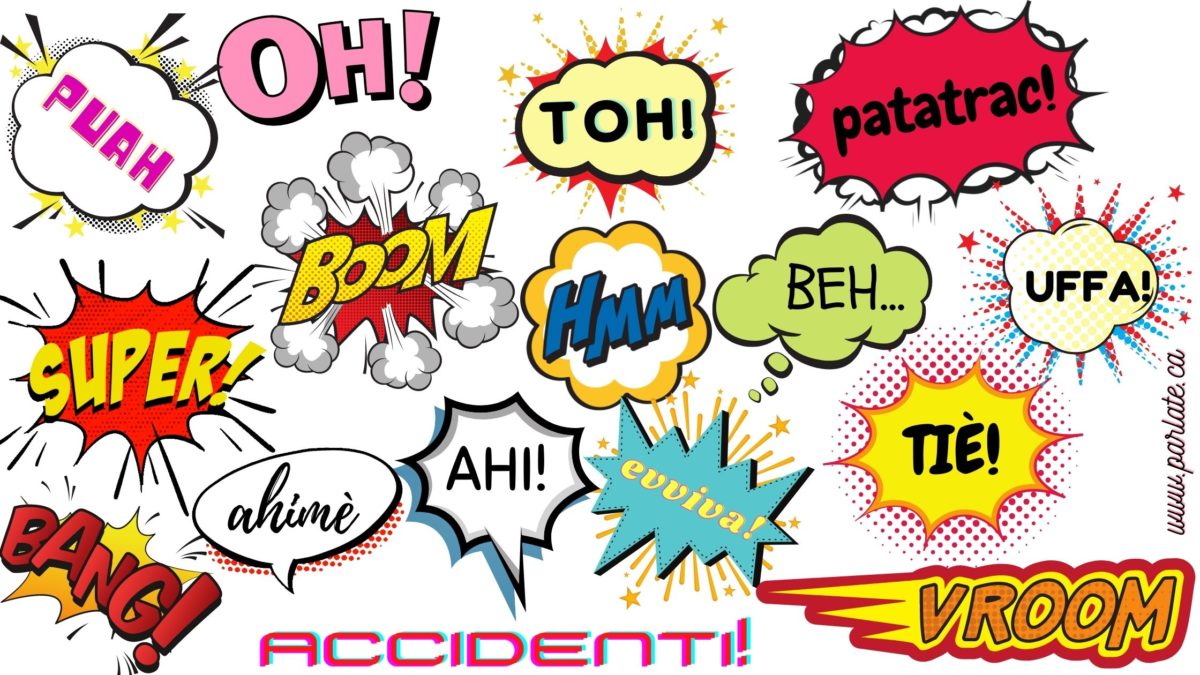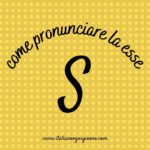(English follows)
Oggi parliamo di interiezioni, di cui l’italiano è ricco. Credo che potrebbero bastare per fare discorsi interi… eh, ahimè, be’ , povero me…mah!
L’interiezione si usa per esprimere emozioni, stati d’animo e reazioni istintive condensate in una sola espressione, senza legami sintattici con il resto della frase.
Molte interiezioni hanno origine vernacolare e vengono utilizzate con frequenza maggiore o minore a seconda della provenienza geografica dell’interlocutore, ma ormai quasi tutte sono entrate a diritto nell’uso della lingua italiana.
Comunque per essere compresa bisogna conoscerne il contesto. Per questo motivo l’interiezione si può definire deittica, cioè legata a un qui e ora ben determinato.
In base all’intonazione, l’interiezione è in grado di assumere il significato di un’intera frase.
Come le espressioni del viso le interiezioni esprimono un messaggio chiaro all’interlocutore senza il bisogno di aggiungere altro.
Invece quando ci troviamo di fronte a un testo scritto è necessario integrare l’interiezione con qualche parola che ne specifichi il senso, siccome non possiamo basarci sul tono con cui viene pronunciata.
Le interiezioni sono divise in due differenti gruppi:
- Interiezioni che generalmente contengono la lettera h, sono brevi e assumono unicamente valore interiettivo come oh, ahimè, ahi…
- Interiezioni che prendono a prestito parti del discorso anche molto diverse tra loro (avverbi, aggettivi, sostantivi, intere proposizioni…) e le utilizzano con valore esclamativo o interrogativo (bene!, evviva!, attenzione!).
Poi all’interno del secondo gruppo si trovano interiezioni improprie e locuzioni interiettive formate da proposizioni e modi di dire (povero me!, santa pazienza!).
All’interno della prima categoria: è facile individuare interiezioni semplici, composte e onomatopeiche:
Semplici – si compongono di uno o due suoni vocalici e possono esprimere dolore (ahi!, ohi!), esitazione o impaccio (ehm, uhm), repulsione (ih!), dubbio (mah, boh), sorpresa (uh!) e molti altri sentimenti e impulsi.
Composte – sono formate generalmente da un’interiezione semplice in combinazione con un pronome personale oppure da due parole (ahimè, orsù, suvvia…). Anche queste voci possiedono diverse sfumature di significato in base al contesto.
Onomatopeiche – come dice il nome stesso, derivano da suoni riconoscibili e provengono per la maggior parte dal mondo del fumetto (puah, splash, clap, toc, wow…).
Sicuramente tutte le interiezioni hanno un valore onomatopeico perché si basano sull’intonazione e il suono, e quindi più che prestare attenzione alle denominazioni dovremmo avere ben chiare le distinzioni e la provenienza etimologica di queste piccole istintive parti del discorso.
È importante poi la giusta grafia delle interiezioni! Spesso troviamo errori molto gravi come ho! al posto di oh!. L’h va messa sempre alla fine (eh, beh, mah, toh…) tranne nel caso in cui ci siano due vocali come per esempio in ehi!, ahi! e i loro composti come ahinoi! e nel caso di ehm e uhm, dove si posiziona in mezzo.
Infine è possibile trovare O senza h quando si tratta di un vocativo (O cari fratelli!, O amica mia!). L’imperativo alla seconda persona singolare troncata di alcuni verbi funge talvolta da interiezione come nel caso di te’ per “tieni”, va’ per “guarda (ant. varda)”. Oppure ancora dall’apocope di alcune parole come be’ per “bene”.
Lista:
ahimè, oh,
povero me!, santa pazienza!
esprimere dolore ahi!, ohi!,
esitazione o impaccio ehm, uhm
repulsione (ih!), dubbio (mah, boh), sorpresa (uh!)
ahimè, orsù, suvvia
puah, splash, clap, toc, wow
eh, beh, mah, toh…)
ehi!, ahi! ahinoi!
O cari fratelli!, O amica mia!
te’ per “tieni”, va’ per “guarda (ant. Varda)
be’ per “bene”.
English version
Today we’re talking about interjections, of which Italian is rich. I think they might be enough to make whole speeches … eh, ahimè, be’ , povero me…mah!
The interjection is used to express emotions, moods and instinctive reactions condensed into a single expression, without syntactic links with the rest of the sentence.
Many interjections have a vernacular origin and are used with greater or lesser frequency depending on the geographical origin of the interlocutor, but now almost all of them have rightfully entered the use of the Italian language.
However, in order to be understood, it is necessary to know the context. For this reason, the interjection can be defined as deictic, that is, linked to a well-determined here and now.
Based on the intonation, the interjection is able to take on the meaning of an entire sentence. Like facial expressions, the interjections express a clear message to the interlocutor without the need to add anything else.
Instead, when we are faced with a written text it is necessary to integrate the interjection with some words that specify its meaning, since we cannot rely on the tone in which it is pronounced.
The interjections are divided into two different groups:
- Interjections that generally contain the letter h, are short and assume only interjective value such as oh, ahimè, ahi…
- Interjections that borrow parts of speech that are also very different from each other (adverbs, adjectives, nouns, whole sentences…) and use them with exclamation or interrogative value (bene!, evviva!, attenzione!).
Then within the second group there are improper interjections and interjective phrases formed by propositions and idioms (povero me!, santa pazienza!).
Within the first category: it is easy to identify simple, compound and onomatopoeic interjections:
Simple – consist of one or two vowel sounds and can express pain (ahi!, ohi!) , hesitation or embarrassment (ehm, uhm) , repulsion (ih!), doubt (mah, boh), surprise (uh!) and many other feelings and impulses.
Compounds – are generally formed by a simple interjection in combination with a personal pronoun or by two words (ahimè, orsù, suvvia…) . These interjections also have different shades of meaning depending on the context.
Onomatopoeic – as the name implies, they derive from recognizable sounds and come for the most part from the world of comics (puah, splash, clap, toc, wow…).
Surely all the interjections have an onomatopoeic value because they are based on intonation and sound, and therefore, rather than paying attention to the denominations, we should be very clear about the distinctions and the etymological origin of these small instinctive parts of the speech.
The correct spelling of the interjections is also important! We often find very serious mistakes like ho! instead of oh!. . The h must always be placed at the end (eh, beh, mah, toh…) except in the case in which there are two vowels such as in ehi!, ahi! and their compounds like ahinoi and in the case of ehm and uhm, where it sits in the middle.
Finally, it is possible to find O without h when it’s a vocative (O cari fratelli!, O amica mia!) . The imperative in the truncated second person singular of some verbs sometimes acts as an interjection as in the case of te’ for “here/take” , va’ for “guarda (ant. varda)” . Or again from the apocope of some words such as be’ for “bene” .







